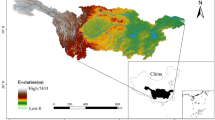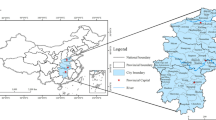Abstract
With the acceleration of urbanization, the increase of urban population has led to earth-shaking changes in urban structure. The structure and function of urban ecosystem have changed, which has affected the service function of urban ecosystem. Urban ecosystem services are closely related to human well-being. Therefore, quantifying urban ecosystem services can better guide urban planning and optimize urban structure. In this chapter, we take China as case study to assess the urban ecosystem services from multiple scales, take Chongqing of China as case study to assess ecosystem service flow, and analyze the entropy value and entropy flow of ecosystem. Firstly, the ecosystem service cluster model was constructed to analyze the changes of ecosystem services in different provinces of China. Secondly, a cluster analysis model was established to group different provinces based on the national scale. Finally, an integrated analysis with the assessment matrix and entropy flow method was used to spatially identify and effectively quantify the ecosystem services flow of Chongqing, China. Our methods and findings can provide theoretical guidance for urban landscape planning, management, and policymaking by considering the ecosystem services and ecosystem health of urban scale.
Access this chapter
Tax calculation will be finalised at checkout
Purchases are for personal use only
Similar content being viewed by others
References
Costanza R, Groot RD, Braat L et al (2017) Twenty years of ecosystem services: how far have we come and how far do we still need to go? Ecosyst Serv 28:1–16. https://doi.org/10.1016/j.ecoser.2017.09.008
Costanza R, D’Arge R, Groot RD et al (1997) The value of the world’s ecosystem services and natural capital. Nature 387:253–260. https://doi.org/10.1038/387253a0
Millennium Ecosystem Assessment (MEA) (2005) Ecosystems and human well-being: synthesis. World Resources Institute, Washington, DC, pp 77–101
Hao R, Yu D, Wu J (2017) Relationship between paired ecosystem services in the grassland and agro-pastoral transitional zone of China using the constraint line method. Agric Ecosyst Environ 240:171–181. https://doi.org/10.1016/j.agee.2017.02.015
Bennett EM, Peterson GD, Gordon LJ (2009) Understanding relationships among multiple ecosystem services. Ecol Lett 12:1394–1404. https://doi.org/10.1111/j.1461-0248.2009.01387.x
Yang G, Ge Y, Xue H et al (2015) Using ecosystem service bundles to detect trade-offs and synergies across urban–rural complexes. Landsc Urban Plan 136:110–121. https://doi.org/10.1016/j.landurbplan.2014.12.006
Deng X, Li Z, Gibson J (2016) A review on trade-off analysis of ecosystem services for sustainable land-use management. J Geogr Sci 26:953–968. https://doi.org/10.1007/s11442-016-1309-9
Yang W, Jin Y, Sun T et al (2018) Trade-offs among ecosystem ser vices in coastal wetlands under the effects of reclamation activities. Ecol Indic 92:354–366. https://doi.org/10.1016/j.ecolind.2017.05.005
Baro F, Gomez-Baggethun E, Haase D (2017) Ecosystem service bundles along the urban-rural gradient: insights for landscape planning and management. Ecosyst Serv 24:147–159. https://doi.org/10.1016/j.ecoser.2017.02.021
Raudsepp-Hearne C, Peterson GD, Bennett EM (2010) Ecosystem service bundles for analyzing tradeoffs in diverse landscapes. Proc Natl Acad Sci U S A 107:5242–5247. https://doi.org/10.1073/pnas.0907284107
Xu Z, Wei H, Fan W et al (2019) Relationships between ecosystem services and human well-being changes based on carbon flow—a case study of the Manas River Basin, Xinjiang, China. Ecosyst Serv 37:100934. https://doi.org/10.1016/j.ecoser.2019.100934
De Vreese R, Van Herzele A, Dendoncker N et al (2019) Are stakeholders’ social representations of nature and landscape compatible with the ecosystem service concept? Ecosyst Serv 37:100911. https://doi.org/10.1016/j.ecoser.2019.100911
Lester SE, Costello C, Halpern BS et al (2013) Evaluating tradeoffs among ecosystem services to inform marine spatial planning. Mar Policy 38:80–89. https://doi.org/10.1016/j.marpol.2012.05.022
Juntti M, Costa H, Nascimento N (2019) Urban environmental quality and wellbeing in the context of incomplete urbanisation in Brazil: integrating directly experienced ecosystem services into planning. Prog Plan. https://doi.org/10.1016/j.progress.2019.04.003
Dittrich A, Seppelt R, Václavík T et al (2017) Integrating ecosystem service bundles and socio-environmental conditions—a national scale analysis from Germany. Ecosyst Serv 28:273–282. https://doi.org/10.1016/j.ecoser.2017.08.007
Asadolahi Z, Salmanmahiny A, Sakieh Y et al (2018) Dynamic trade-off analysis of multiple ecosystem services under land use change scenarios: towards putting ecosystem services into planning in Iran. Ecol Complex 36:250–260. https://doi.org/10.1016/j.ecocom.2018.09.003
Xie G, Zhang C, Zhen L et al (2017) Dynamic changes in the value of China’s ecosystem services. Ecosyst Serv 26:146–154. https://doi.org/10.1016/j.ecoser.2017.06.010
Teoh SHS, Symes WS, Sun H et al (2019) A global meta-analysis of the economic values of provisioning and cultural ecosystem services. Sci Total Environ 649:1293–1298. https://doi.org/10.1016/j.scitotenv.2018.08.422
Odum HT, Odum EP (2000) The energetic basis for valuation of ecosystem services. Ecosystems 3:21–23. https://doi.org/10.1007/s100210000005
Yang Q, Liu GY, Casazza M et al (2018) Campbell, E.T.; Giannetti, B.F.; Brown, M.T. Development of a new framework for non-monetary accounting on ecosystem services valuation. Ecosyst Serv 34:37–54. https://doi.org/10.1016/j.ecoser.2018.09.006
Ouyang Z, Zheng H, Xiao Y et al (2016) Improvements in ecosystem services from investments in natural capital. Science 352:1455–1459. https://doi.org/10.1126/science.aaf2295
Li T, Lü Y, Fu B et al (2019) Bundling ecosystem services for detecting their interactions driven by large-scale vegetation restoration: enhanced services while depressed synergies. Ecol Indic 99:332–342. https://doi.org/10.1016/j.ecolind.2018.12.041
Sun F, Xiang J, Tao Y et al (2019) Mapping the social values for ecosystem services in urban green spaces: integrating a visitor-employed photography method into SolVES. Urban For Urban Green 38:105–113. https://doi.org/10.1016/j.ufug.2018.11.012
Willcock S, Martínez-López J, Hooftman DAP et al (2018) Machine learning for eco system services. Ecosyst Serv. https://doi.org/10.1016/j.ecoser.2018.04.004
Bagstad KJ, Johnson GW, Voigt B et al (2013) Spatial dynamics of ecosystem service flows: a comprehensive approach to quantifying actual services. Ecosyst Serv 4:117–125. https://doi.org/10.1016/j.ecoser.2012.07.012
Queiroz C, Meacham M, Richter K et al (2015) Mapping bundles of ecosystem services reveals distinct types of multifunctionality within a Swedish landscape. Ambio 44(Suppl 1):S89–S101. https://doi.org/10.1007/s13280-014-0601-0
Zhao M, Peng J, Liu Y et al (2018) (2018) Mapping Watershed-Level Ecosystem Service Bundles in the Pearl River Delta, China. Ecol Econ 152:106–117. https://doi.org/10.1016/j.ecolecon.2018.04.023
Yang Y, Zheng H, Kong L et al (2019) Mapping ecosystem services bundles to detect high- and low-value ecosystem services areas for land use management. J Clean Prod 225:11–17. https://doi.org/10.1016/j.jclepro.2019.03.242
Renard D, Rhemtulla JM, Bennett EM (2015) Historical dynamics in ecosystem service bundles. Proc Natl Acad Sci U S A 112(43):13411–13416. https://doi.org/10.1073/pnas.1502565112
Xie G, Lu C, Leng Y et al (2003) Ecological assets valuation of the Tibetan Plateau. J Nat Resour 18:189–196. https://doi.org/10.3321/j.issn:1000-3037.2003.02.010
Adolfsson A, Ackerman M, Brownstein NC (2019) To cluster, or not to cluster: an analysis of clusterability methods. Pattern Recogn 88:13–26. https://doi.org/10.1016/j.patcog.2018.10.026
Oka C, Aiba M, Nakashizuka T (2019) Phylogenetic clustering in beneficial attributes of tree species directly linked to provisioning, regulating and cultural ecosystem services. Ecol Indic 96:477–495. https://doi.org/10.1016/j.ecolind.2018.09.035
Murtagh F, Legendre P (2014) Ward’s hierarchical agglomerative clustering method: which algorithms implement ward’s criterion? J Classif 31:274–295. https://doi.org/10.1007/s00357-014-9161-z
Lefever DW (1926) Measuring geographic concentration by means of the standard deviational ellipse. Am J Sociol 32:88–94. https://doi.org/10.1086/214027
Yuill RS (1971) The standard deviational ellipse; an updated tool for spatial de scription. Geogr Annaler Ser B Human Geogr 53:28–39. https://doi.org/10.2307/490885
Gong J (2002) Clarifying the standard deviational ellipse. Geogr Anal 34:155–167. https://doi.org/10.1111/j.1538-4632.2002.tb01082.x
He Y, Chen Y, Tang H et al (2011) Exploring spatial change and gravity center movement for ecosystem services value using a spatially explicit ecosystem services value index and gravity model. Environ Monit Assess 175:563–571. https://doi.org/10.1007/s10661-010-1551-z
Du Q, Zhou J, Pan T et al (2019) Relationship of carbon emissions and economic growth in China’s construction industry. J Clean Prod 220:99–109. https://doi.org/10.1016/j.jclepro.2019.02.123
Yao J, He X, Chen W (2018) The latest progress in ecosystem service flow research methods. Chin J Appl Ecol 29:335–342. https://doi.org/10.13287/j.1001-9332.201801.018
Li J, Yang L, Yang L et al (2018) Quantitative assessment of urban ecosystem services flow based on entropy theory: a case study of Beijing, China. Chin J Appl Ecol 29:987–996. https://doi.org/10.13287/j.1001-9332.201803.017
Johnson GW, Bagstad KJ, Snapp RR et al (2018) Service path attribution networks (SPANs): spatially quantifying the flow of ecosystem services from landscapes to people. International Conference on Computational Science and Its Applications, Berlin, Heidelberg, pp 238–253. https://doi.org/10.1007/978-3-642-12156-2_18
Guo Z, Xiao X, Li D (2000) An assessment of ecosystem services: water flow regulation and hydroelectric power production. Ecol Appl 10:925–936
Serna Chavez HM, Schulp C, Van Bodegom P et al (2014) A quantitative framework for assessing spatial flows of ecosystem services. Ecol Indic 39:24–33. https://doi.org/10.1016/j.ecolind.2013.11.024
Burkhard B, Kroll F, Nedkov S et al (2012) Mapping supply, demand and budgets of ecosystem services. Ecol Indic 21:17–19. https://doi.org/10.1016/j.ecolind.2011.06.019
Xu G, Ren W, Guo S et al (2017) Analyses on the development of lake complex eco system health based on entropy theory. China Environ Sci 37:795–800
Greenhalgh S, Samarasinghe O, Curran-Cournane F (2017) Using ecosystem services to underpin cost–benefit analysis: is it a way to protect finite soil resources. Ecosyst Serv 27:1–14. https://doi.org/10.1016/j.ecoser.2017.07.005
Author information
Authors and Affiliations
Editor information
Editors and Affiliations
Rights and permissions
Copyright information
© 2023 The Author(s), under exclusive license to Springer Nature Singapore Pte Ltd.
About this chapter
Cite this chapter
Guan, D., Zhou, L. (2023). Qualitative Assessment of Urban Ecosystem Services Based on GIS. In: Gao, W. (eds) Digital Analysis of Urban Structure and Its Environment Implication. Advances in 21st Century Human Settlements. Springer, Singapore. https://doi.org/10.1007/978-981-19-6641-5_5
Download citation
DOI: https://doi.org/10.1007/978-981-19-6641-5_5
Published:
Publisher Name: Springer, Singapore
Print ISBN: 978-981-19-6640-8
Online ISBN: 978-981-19-6641-5
eBook Packages: Biomedical and Life SciencesBiomedical and Life Sciences (R0)




